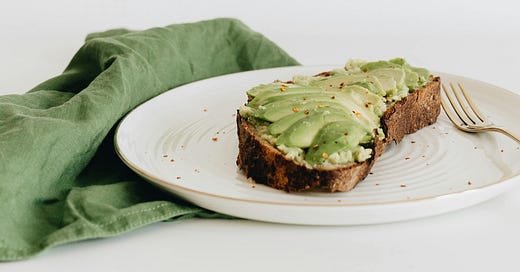How To Holistically Heal...With A Biodiverse Diet
Why Eating The Same Food Every Day Hinders Your Health
Experience this Newsletter in all its online glory. Go here
In this edition…
Healing: A Mono Diet
Reverence: A Biodiverse Diet
Exploring: A Rotation Diet
1. Healing: A Mono Diet
As a naturopath, I often start my consultations by reviewing the detailed health questionnaires my patients fill out before we meet. One section that always captures my attention is the food diary. Initially, I assume these entries reflect just a single day’s example of their eating habits. However, when I inquire further, I’m frequently told that this isn’t a snapshot—it’s their daily reality.
More times than not, patients explain that they eat the same foods every day, following what is essentially a mono diet. They offer valid reasons:
"It’s easy on my stomach."
"There are no surprises; I know what to expect."
"It simplifies my life; I don’t have to think about what to eat."
"It’s budget-friendly and time-saving."
"It’s all I know how to prepare."
While this level of consistency might seem like a foolproof way to manage symptoms such as bloating, indigestion, or fatigue, I often find that their health tells a different story. Let’s explore what a mono diet looks like, why it appeals to so many, and whether it’s truly the answer to improving long-term health.
What Is a Mono Diet?
A mono diet is not necessarily the restrictive "one-food-only" approach we often hear about (e.g., only eating bananas or potatoes). Instead, in practice, it often means eating the same limited set of foods every day, with little to no variation. Here’s a common example of what a mono diet might look like:
Breakfast:
Toasted white sourdough bread with avocado or peanut butter.
Black coffee or tea.
Lunch:
Grilled chicken breast with steamed white rice.
Lightly cooked zucchini.
Dinner:
Salmon with potatoes and green beans.
Snacks:
Handful of almonds or crackers.
A piece of fruit like an apple or banana (optional).
The simplicity of this diet appeals to people with chronic gut issues because it feels predictable and safe. It’s perceived as "easy to digest," and for many, this consistency reduces the anxiety around eating. But is this narrow, repetitive eating pattern actually serving their overall health?
Why Patients Choose a Mono Diet
The reasoning behind a mono diet often makes perfect sense, especially when someone is struggling with digestive symptoms or has experienced food intolerances in the past. Some of the most common justifications include:
Simplicity: "I don’t have to overthink my meals."
Digestive Safety: "These foods are gentle on my stomach and don’t cause discomfort."
Routine: "I’m busy, and this saves me time."
Emotional Comfort: "It’s the one thing I can control when everything else feels chaotic."
Fear of Symptoms: "Trying new foods makes me anxious about how my body will react."
For individuals with a history of chronic gut symptoms such as bloating, gas, diarrhoea, or constipation, this logic feels like a survival mechanism. However, while the intention is to reduce symptoms and maintain stability, the reality is often the opposite.
The Hidden Costs of a Mono Diet
Although the mono diet may initially seem like a solution, I often see patients presenting with a host of ongoing health issues, including:
Poor Gut Health: A diverse gut microbiome thrives on a wide variety of plant-based foods. A repetitive diet starves beneficial bacteria of the nutrients they need, reducing microbial diversity and perpetuating gut issues.
Nutritional Deficiencies: Even nutrient-rich foods like salmon or zucchini can’t cover all the essential vitamins and minerals your body needs. Over time, limited food choices can lead to deficiencies in key nutrients such as fibre, magnesium, B vitamins, and omega-3s. Check out this free webinar on why we’re deficient in B12, Magnesium, Iron and Zinc. Go here
Low Energy and Mood: Patients often report persistent fatigue, brain fog, and low mood, which may be linked to both inadequate nutrient intake and imbalanced blood sugar levels from a lack of dietary variety.
Food Intolerances: Ironically, eating the same foods every day can increase sensitivity to those foods. Without variation, your immune system may begin to see repetitive proteins as a threat, leading to intolerances or sensitivities.
Weight and Metabolism Challenges: A narrow diet can slow metabolism and make it difficult to maintain a healthy weight. Even with "safe" foods, the body needs diversity to function optimally.
Does the Mono Diet Truly Help?
Despite patients’ best intentions, the mono diet often leads to stagnation rather than relief. While their symptoms may feel slightly more manageable in the short term, they frequently present with long-term issues such as:
Chronic fatigue. Discover more here
Brain fog. Discover more here
Sleep disturbances. Discover more here
Digestive discomfort (even on their "safe" foods). Discover more here
Hormonal imbalances.
This raises an important question: does the diet actually improve symptoms, or does it simply mask deeper issues that remain unresolved?
2. Reverence: A Biodiverse Diet
Shifting to a Biodiverse Diet: What It Is and Why It Matters
In contrast to the restrictive nature of a mono diet, a biodiverse diet emphasises the consumption of a wide variety of foods, particularly plant-based options, to promote overall health and nourish the gut microbiome. This approach aligns with nature's diversity and ensures that the body receives a broad spectrum of nutrients essential for optimal function.
What Is a Biodiverse Diet?
A biodiverse diet focuses on including different food groups and a wide variety of foods within those groups. The goal is to consume a variety of **plant-based foods each week, including vegetables, fruits, nuts, seeds, legumes, whole grains, and pseudocereals, as well as fermented vegetables along with healthy protein and fats from pastured or grass fed meats and / or wild or sustainable fish & seafood, eggs and dairy. This diversity supports gut health, enhances nutrient absorption, and nurtures overall well-being.
Please note: I always recommend choosing plant-based foods that are organic or, at the very least, part of the Clean Fifteen—those not grown with toxic chemicals. Discover more about the Clean Fifteen and the Dirty Dozen. Always opt for organic when it comes to items on the Dirty Dozen list. Go here
Example of a Biodiverse Diet in a day:
Breakfast:
Overnight oats made with almond milk, coconut yoghurt, topped with blueberries, chia seeds, walnuts and shredded coconut.
Lunch:
A colourful salad with mixed greens, roasted sweet potato, quinoa, avocado, chickpeas, and a lemon tahini dressing.
A serve of protein - 2 eggs or grilled wild salmon (not Tasmanian) or whiting fillets
A side of fermented kimchi (if tolerated).
Dinner:
Grilled lamb chops with a side of roasted Brussels sprouts, steamed asparagus, and wild rice.
A drizzle of olive oil and fresh lemon juice and freshly chopped herbs.
A side of fermented sauerkraut (if tolerated).
Snacks:
A mix of raw vegetables (carrot sticks, celery, capsicum) with hummus.
Fresh fruit with cheese.
Benefits of a Biodiverse Diet
Enhanced Gut Health: A variety of plant-based foods fuels the gut microbiome, increasing microbial diversity and improving digestion and immunity.
Better Nutrient Intake: Consuming a wide range of foods ensures your body receives essential vitamins, minerals, antioxidants, and phytonutrients that may be missing in a mono diet.
Improved Mood and Energy: The fibre and nutrients in a biodiverse diet help regulate blood sugar levels, reduce inflammation, and support brain health, resulting in better mood and sustained energy.
Reduced Risk of Chronic Disease: Diet diversity is linked to lower risks of heart disease, diabetes, and certain cancers due to its anti-inflammatory and nutrient-rich properties.
Supports Weight Management: High-fibre, nutrient-dense foods in a biodiverse diet can improve satiety and metabolism, helping maintain a healthy weight.
3. Exploring: A Rotation Diet
The Path Forward: Reintroducing Variety
A key part of breaking the mono diet cycle is gradually expanding food diversity in a way that feels safe and supportive. Here are some strategies to consider:
i. Introduce One New Food at a Time: Start with low-FODMAP fruits and vegetables and observe your body’s response.
10 Low FODMAP Vegetables to try:
Carrots
Cucumber
Zucchini (small portions)
Bok choy
Spinach (English or baby spinach)
Kale (in small quantities)
Capsicum
Lettuce (iceberg or butter)
Green beans
Tomato (common and Roma varieties in moderate amounts)
10 Low FODMAP Fruits to try:
Bananas (ripe, but avoid overripe)
Oranges
Strawberries
Blueberries
Grapes
Kiwi
Pineapple
Cantaloupe (rockmelon)
Dragon fruit (pitaya)
Papaya
ii. Focus on Gut Healing: Incorporate gut-supportive foods like bone broth, fermented foods (if tolerated), and prebiotic fibres to rebuild microbial diversity. Ask me below for an excellent prebiotic powder to kick things off (if you live in Australia, we can post one to you)
iii. Rotate Foods Weekly: Try swapping your go-to proteins, grains, and vegetables for alternatives each week (e.g., replace chicken with pastured pork, rice with quinoa, or zucchini with yellow squash).
iv. Diversify Plant-Based Foods: Aim for a variety of different plant foods (vegetables, fruits, nuts, seeds, legumes, whole grains, and pseudocereals, as well as fermented vegetables) per week to nourish your gut microbiome.
v. Address the Underlying Issues: Work with a practitioner to identify and treat root causes of gut discomfort, such as dysbiosis, SIBO, or food sensitivities.
Missed out on our New Year Cleanse & Health Reset?
Download The Summer Cleanse Foods & Recipes eBook
Buy here







